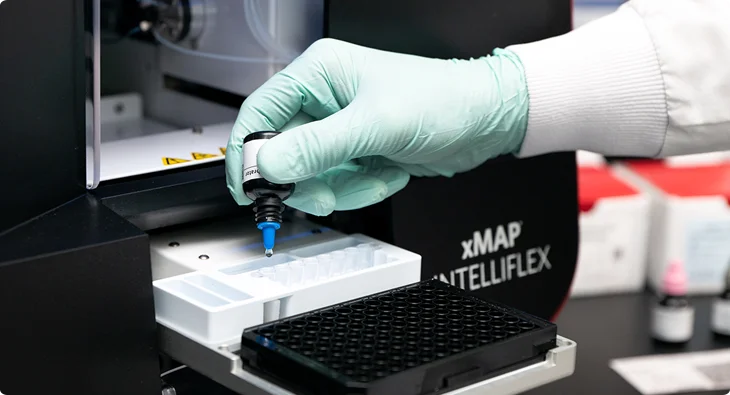Webinar: Designing a COVID-19 Vaccine Efficacy Assay with the xMAP INTELLIFLEX® System
In Chicago, scientists employed the dual reporter channel to generate more data without incurring more costs
We always enjoy seeing xMAP® assay users talk about their experience with the technology, but it’s even more exciting to get feedback on our newest platforms and features. In a recent webinar, Dr. Jeffrey Borgia from Rush University Medical Center in Chicago spoke about his team’s experience developing a high-throughput serology assay for monitoring the immune response to COVID-19 vaccines using the xMAP INTELLIFLEX® System.
If you don’t have time for the full webinar, check out these quick highlights.
When it comes to COVID-19, testing has been a shifting landscape
Dr. Borgia pointed out that test developers like his team have had to work around the types of tests needed during the pandemic evolving multiple times over the last two years. At the start of the outbreak, the focus was initially to identify and contain current infections. Then there was a shift to antibody tests to help determine whether people had already been infected. After that, there was a need for vaccine efficacy assays that could quantify someone’s immune response to either COVID-19 vaccination or infection. More recently, demand has grown for assays to identify breakthrough infections in vaccinated individuals and to identify waning immunity that might indicate when it’s time for a booster shot.
Serology assay, version one
Early in the pandemic, Dr. Borgia’s team developed a serological assay designed to evaluate antibodies to four antigens using xMAP tech: the spike, nucleocapsid, matrix, and envelope proteins. The test they designed could monitor both neutralizing and non-neutralizing antibodies, and importantly, required less than 2 µL of sample. Paired with a FLEXMAP 3D® System, the automated workflow permitted testing more than 1,000 samples per day. Dr. Borgia and his team validated the test on both plasma and dried blood spot samples.
Validation studies in more than 1,000 samples showed that the assay featured “near-perfect sensitivity and specificity,” Dr. Borgia said. “Our overall accuracy was over 99 percent.”
Vaccine efficacy testing with xMAP INTELLIFLEX
Later, the team created a separate serology assay to quantify the immune response to COVID-19 vaccination. By this time, the lab had adopted a beta version of the xMAP INTELLIFLEX® System, which provides enhanced multiplexing capabilities with the addition of a dual reporter channel. This feature makes it possible to evaluate two isotypes at a time—such as IgG and IgM—and generate twice as much data from the same sample and reagent volumes as any other xMAP assay.
The new assay focused on antibodies to the spike, nucleocapsid, and matrix proteins, analyzing IgG, IgM, and IgA for each. Dr. Borgia described a number of validation and optimization steps for the new instrument, allowing the team to identify the appropriate incubation time and evaluate intra-assay and inter-assay precision.
What they were really interested in, of course, were the results from the longitudinal monitoring of immune responses to vaccination, particularly among immunocompromised patients. The data they generated supports the recommendation for booster shots, and showed that a third dose helped trigger as much protection in immunocompromised individuals as two doses did in people with a normal immune system.
The xMAP INTELLIFLEX System allowed the team to generate high-quality results at higher throughput and lower cost, Dr. Borgia also noted.
As xMAP INTELLIFLEX systems ramp up next year and beyond, we’re really looking forward to seeing all of the innovative ways the xMAP community put the new dual reporter feature to good use.
For more information about this study, check out the webinar!
For Research Use Only. Not for use in diagnostic procedures.


